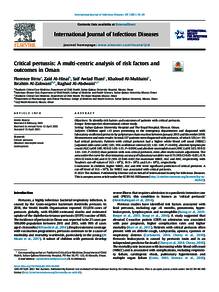Document
Critical pertussis : a multi-centric analysis of risk factors and outcomes in Oman.
Identifier
DOI: 10.1016/j.ijid.2021.04.046
Source
International Journal of Infectious Diseases. v. 107, p. 53-58
Contributors
Al-Hinai, Zaid., Author
Thani, Saif Awlad., Author
Al-Mukhainiyah, Khaloud., Author
Al-Zakwani, Ibrahim., Author
Al-Abdwaniyah, Raghad., Author
Country
Netherlands.
City
Amsterdam
Publisher
Elsevier B.V.
Gregorian
2021-06-01
Language
English
English abstract
Objectives: To identify risk factors and outcomes of patients with critical pertussis. Design: Retrospective observational cohort study. Setting: Sultan Qaboos University Hospital and The Royal Hospital, Muscat, Oman. Subjects: Children aged 13 years presenting to the emergency departments and diagnosed with laboratory-confirmed pertussis by polymerase chain reaction between January 2013 and December 2018. Measurements and main results: In total, 157 patients were diagnosed with pertussis, of which 12% (n = 19) had critical pertussis. Patients with critical pertussis had a higher white blood cell count (WBCC) [adjusted odds ratio (aOR) 1.05; 95% confidence interval (CI) 1.02–1.08; P = 0.003], absolute lymphocyte count (ALC) (aOR 1.08; 95% CI 1.03–1.15; P = 0.004) and absolute neutrophil count (ANC) (aOR 1.05; 95% CI 1.01–1.10; P = 0.032) than patients with non-critical pertussis, even after multi-variate adjustment. The area under the curve for discriminatory accuracy of laboratory variables was 0.75 (95% CI 0.65–0.85), 0.74 (95% CI 0.64–0.84) and 0.72 (95% CI 0.60–0.83) for maximum WBCC, ALC and ANC, respectively, with Youden's cut-off values of 31.5 × 109/L, 19.9 × 109/L and 5.0 × 109/L, respectively. Conclusions: In children, higher WBCC, ALC and ANC were significant predictors of critical pertussis. A cut-off level of 31.5 × 109/L for WBCC was associated with critical pertussis.
ISSN
1201-9712
Category
Journal articles

